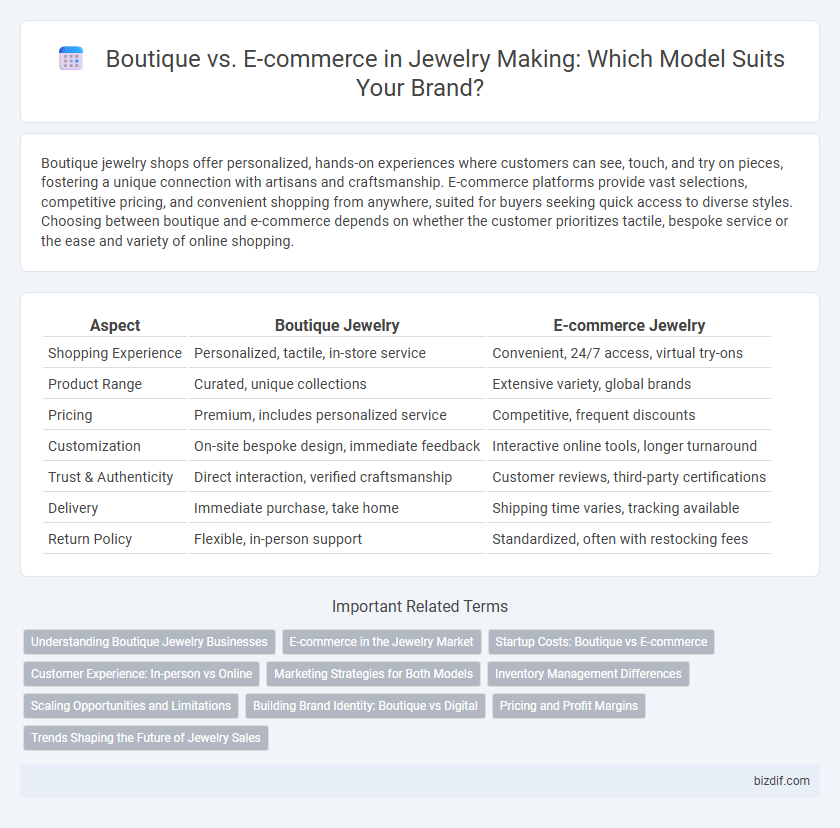Boutique jewelry shops offer personalized, hands-on experiences where customers can see, touch, and try on pieces, fostering a unique connection with artisans and craftsmanship. E-commerce platforms provide vast selections, competitive pricing, and convenient shopping from anywhere, suited for buyers seeking quick access to diverse styles. Choosing between boutique and e-commerce depends on whether the customer prioritizes tactile, bespoke service or the ease and variety of online shopping.
Table of Comparison
| Aspect | Boutique Jewelry | E-commerce Jewelry |
|---|---|---|
| Shopping Experience | Personalized, tactile, in-store service | Convenient, 24/7 access, virtual try-ons |
| Product Range | Curated, unique collections | Extensive variety, global brands |
| Pricing | Premium, includes personalized service | Competitive, frequent discounts |
| Customization | On-site bespoke design, immediate feedback | Interactive online tools, longer turnaround |
| Trust & Authenticity | Direct interaction, verified craftsmanship | Customer reviews, third-party certifications |
| Delivery | Immediate purchase, take home | Shipping time varies, tracking available |
| Return Policy | Flexible, in-person support | Standardized, often with restocking fees |
Understanding Boutique Jewelry Businesses
Boutique jewelry businesses prioritize personalized customer experiences and unique, handcrafted designs that reflect artisanal craftsmanship, often found in localized physical stores. These boutiques emphasize exclusive collections and direct customer interaction, fostering brand loyalty through custom fittings and detailed consultations. Unlike e-commerce platforms, boutique shops leverage tangible product experiences and in-person service to differentiate their market presence in the jewelry industry.
E-commerce in the Jewelry Market
E-commerce in the jewelry market offers unparalleled access to a global customer base, enabling artisans and brands to showcase a diverse range of pieces beyond traditional boutique limitations. Advanced online platforms provide interactive features like 3D viewing and virtual try-ons, enhancing the shopping experience and driving higher engagement. Leveraging data analytics, e-commerce businesses optimize inventory, personalize marketing strategies, and respond swiftly to market trends, positioning themselves for scalable growth in the competitive jewelry industry.
Startup Costs: Boutique vs E-commerce
Starting a boutique for jewelry making typically requires higher startup costs, including expenses for leasing retail space, interior design, and inventory display. E-commerce platforms reduce initial investment by eliminating the need for physical storefronts, focusing costs primarily on website development, digital marketing, and inventory management. Entrepreneurs must weigh factors such as fixed overhead versus scalability when choosing between boutique and e-commerce models for jewelry sales.
Customer Experience: In-person vs Online
Boutique jewelry stores provide a tactile customer experience, allowing clients to see, touch, and try pieces while receiving personalized, expert guidance from staff. E-commerce platforms offer convenience and extensive product selections but lack the sensory and interpersonal interactions found in physical stores. The choice between boutique and online shopping significantly influences customer satisfaction, emphasizing the trade-off between hands-on engagement and digital accessibility.
Marketing Strategies for Both Models
Boutique jewelry marketing relies heavily on personalized customer experiences, leveraging in-store events, exclusive collections, and local community engagement to build brand loyalty. E-commerce strategies prioritize digital advertising, SEO optimization, content marketing, influencer collaborations, and targeted email campaigns to drive traffic and conversions. Both models benefit from data analytics to tailor promotions based on consumer behavior and preferences.
Inventory Management Differences
Boutique jewelry stores maintain a limited, carefully curated inventory to offer exclusive, high-quality pieces with personalized customer service, facilitating easier stock control but limited product variety. E-commerce platforms manage a wide-ranging inventory using advanced software for real-time tracking and automated restocking, enabling efficient handling of large stock volumes and diverse designs. Inventory management in boutiques emphasizes craftsmanship and uniqueness, while e-commerce focuses on scalability and operational efficiency.
Scaling Opportunities and Limitations
Boutique jewelry businesses offer personalized customer experiences and exclusivity but face limitations in reaching a broad audience and scaling rapidly due to physical space and local market constraints. E-commerce platforms provide vast scaling opportunities by accessing global markets, utilizing digital marketing, and automating sales processes, yet they require strong online brand presence and robust logistics to maintain customer satisfaction. Balancing boutique craftsmanship with e-commerce scalability enables jewelry makers to expand their market reach while preserving artisanal quality.
Building Brand Identity: Boutique vs Digital
Boutique jewelry stores offer a tactile, personalized experience that fosters strong emotional connections and distinctive brand identity through in-person customer service and curated ambiance. E-commerce platforms leverage advanced digital tools, such as SEO, social media marketing, and user-generated content, to build scalable brand recognition and reach a global audience efficiently. Integrating storytelling, high-quality imagery, and customer reviews online enhances brand authenticity and trust, crucial for jewelry brands competing in digital markets.
Pricing and Profit Margins
Boutique jewelry stores often have higher pricing due to exclusive designs and premium in-store experiences, which can lead to increased profit margins per piece. E-commerce platforms benefit from lower overhead costs, allowing for more competitive pricing but typically narrower profit margins. Strategic pricing tailored to each sales channel maximizes overall profitability in the jewelry market.
Trends Shaping the Future of Jewelry Sales
Boutique jewelry stores offer personalized customer experiences and exclusive, handcrafted designs that appeal to niche markets and luxury buyers. E-commerce platforms leverage AI-driven recommendations, virtual try-ons, and global reach to meet the growing demand for convenience and customization. Omnichannel retail strategies combining physical boutiques with digital storefronts are driving the most significant growth in jewelry sales worldwide.
Boutique vs E-commerce Infographic

 bizdif.com
bizdif.com